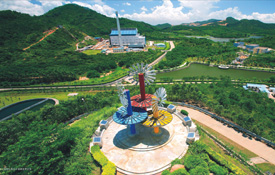|
 |
 |
|
Low-carbon campaign (COURTESY OF ZHONGSHAN CPC COMMITTEE PUBLICITY DEPARTMENT) |
Bike path (COURTESY OF ZHONGSHAN CPC COMMITTEE PUBLICITY DEPARTMENT) |
Zhongshan, south China's Guangdong Province, is the hometown of Dr. Sun Yat-sen, the man who initiated China's democratic revolution in the early 20th century. Situated in the southern part of the Pearl River Delta and covering an area of 1,800 square km, Zhongshan is geographically connected with Guangzhou, the provincial capital, to the north, and is in the vicinity of Hong Kong and Macao. Zhongshan is famous for its large population of overseas returnees and is home to a natural environment conducive to living and working.
The city is surrounded by forest. The roads are lined with trees and the people are surrounded by landscape. Gaining such honorable titles as National Model City in Environment Protection in 1998 and National Eco-City in 2011, Zhongshan has over the years allotted the same priority to environmental protection as to economic and social development.
In 2012, Zhongshan's GDP reached 244.1 billion yuan ($38.87 billion), ranking fifth in Guangdong Province, and up by 11 percent, Its per-capita GDP stood at 77,527 yuan ($12,345). Despite rapid economic growth, Zhongshan still faces challenges regarding the traditional model of developing labor-extensive industries. Since the start of this century when its traditional means of development peaked, Zhongshan has adopted a new comprehensive strategy integrating economic, political, cultural, social and ecological development. The city has chosen the path of "green development" in an effort to realize harmony between humans and nature and between city and nature.
In 2012, Zhongshan established the goal of building itself as a National Ecological Civilization Model City. It is working to reduce its energy consumption per unit of GDP to less than 0.515 tons of coal equivalent and reduce carbon emissions per unit of GDP to less than 0.4 tons in order to meet national standards.
In tandem
Zhongshan has always attached great importance to environmental protection and ecological development alongside economic growth.
Garbage disposal is a chronic malady in Chinese cities. To deal with this problem, Zhongshan has created a plan for the construction of three highly complex garbage disposal bases in order to realize its goals of garbage reduction, using garbage as a resource and handling garbage in a hazard-free manner.
Zhongshan has made a uniform plan for environmental protection across the city and adopts the same assessment standard for environmental protection and ecological development in both urban and rural areas. The city has invested 2.38 billion yuan ($378.98 million) in the construction of three garbage disposal facilities in the northern, southern and central areas of the city, with a daily disposal capacity of 3,100 tons. In urban areas, 100 percent of garbage has been managed in a hazard-free manner.
Water is an essential factor for ecological security. Zhongshan has made sewage disposal facilities a fundamental part of its construction of an eco-city, building centralized sewage disposal facilities for industries of electroplating, printing and yarn dying.
All the townships and districts of the city currently have established sewage disposal factories, with a sewage-collecting network spanning 669 km with a daily disposal capacity of 950,000 tons. In Zhongshan, 87.5 percent of the sewage can be disposed.
Moreover, Zhongshan has combined environmental protection with economic restructuring, the transformation of its economic growth pattern and the overall improvement of people's well-being. In the last five years, the city has invested 17 billion yuan ($2.71 billion) in 12 environmental protection projects, including afforestation and wetland recovery. None of the city's 18 townships have been left untouched as the city moves forward to a greener future.
During the 11th Five-Year Plan (2006-10)period, Zhongshan ranked first in Guangdong Province for emission reduction of major pollutants and is the fist city in the province to become a National Model City in Environment Protection. In July 2011, Zhongshan became the only prefecture-level National Eco-City.
 |
 |
|
A bird's-eye view of Zhongshan (COURTESY OF ZHONGSHAN CPC COMMITTEE PUBLICITY DEPARTMENT) |
Garbage disposal base (COURTESY OF ZHONGSHAN CPC COMMITTEE PUBLICITY DEPARTMENT) |
Green innovation
Zhongshan has gained many titles and honors, including National Garden City, UN Habitat Scroll of Honor Award, National Model City in Environment Protection, National Civilized City, National Famous Historical and Cultural City and National Eco-City. All of these have been achieved through the city's eco-oriented efforts.
Building a national ecological city will be one of the keys to breaking the bottleneck of Zhongshan's traditional development pattern during the 12th Five-Year Plan (2011-15) period.
Xue Xiaofeng, Secretary of the Zhongshan Municipal Committee of the Communist Party of China, says the city will make "devoting major efforts to a green development strategy and protecting the environment" a major focus of its developments plans over the next few years.
"Zhongshan will promote ecological culture, propose a green lifestyle and nurture a low-carbon production and consumption pattern," Xue said. "We will not only strengthen thrifty utilization of resources and protection of ecological environment, but also enhance protection of the natural landscape so as to leave a beautiful environment for our future generations."
Zhongshan's environmental protection program has a planned investment of 6 billion yuan ($955.41 million), much of which will be directed toward modernizing its water facilities and restoring the Qijiang River, the city's major water source.
Zhongshan will work hard to establish an ecological-friendly economy by 2020, meeting international standards in green production and reducing carbon emissions in an effort to create a city binding humans and nature.
Email us at: yushujun@bjreview.com | 